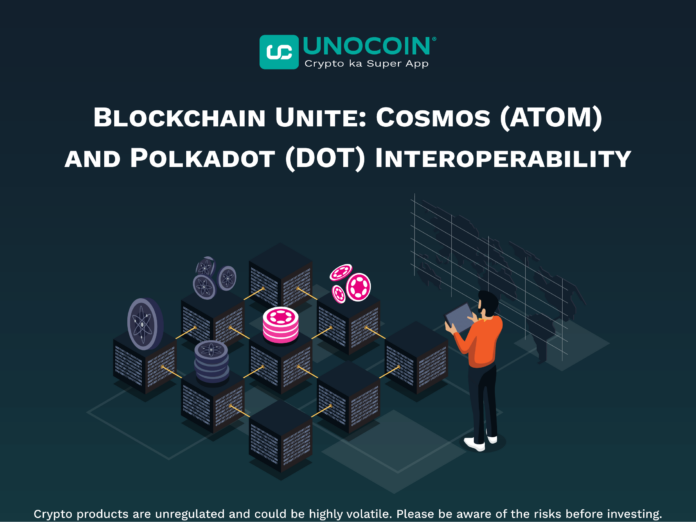Cosmos and Polkadot: Navigating the New Frontier of Cross-Chain Interoperability
1. Cosmos (ATOM): Weaving an Interconnected Blockchain Fabric
In the dynamic field of blockchain technology, interoperability has become a key frontier, and Cosmos (ATOM) is at the forefront of this revolutionary movement. As a project dedicated to creating an interconnected blockchain ecosystem, Cosmos has been instrumental in reshaping how different blockchain networks communicate and share information. Let’s dive into the intricacies of Cosmos and explore its role in achieving cross-chain interoperability.
1.1 Understanding Cosmos: A Vision of the Internet of Blockchains
Often referred to as the “internet of blockchains,” Cosmos envisions a future where different blockchain networks can seamlessly communicate and trade with each other. At its core, Cosmos provides a framework for building interoperable blockchains that allow them to connect and share data without compromising security or decentralization. Cosmos Hub serves as the central hub in this ecosystem and facilitates communication between different blockchains, each of which is referred to as a “zone”.
1.2 The Cosmos Hub: Nexus for cross-chain transactions
Cosmos Hub uses the Inter-Blockchain Communication (IBC) protocol, a breakthrough technology that enables secure and trusted communication between blockchains within the Cosmos network. IBC enables the transfer of assets and data across different zones, supporting a decentralized and interconnected ecosystem. Cosmos solves the problem of siled blockchain networks by providing a scalable and interoperable solution that can potentially unite various decentralized applications (DApps) and blockchain communities.
2. Polkadot (DOT): Bridging blockchains for a multi-chain future
As Cosmos weaves the interconnected fabric of blockchains, Polkadot (DOT) is emerging as another powerful force in the cross-chain interoperability landscape. Polkadot, founded by Dr. Gavin Wood, one of the co-founders of Ethereum, presents a unique approach to interoperability with an emphasis on a multi-chain framework. Let’s explore the intricacies of Polkadot and how it tries to bridge the various blockchains within its ecosystem.
2.1 The Polkadot Architecture: Parachains and Relay Chains
Polkadot’s architecture revolves around the concept of parachains – individual blockchains that connect to the main relay chain. The relay chain serves as the heart of the Polkadot network, coordinating communication between the various parachains. Polkadot’s innovative design enables a shared security model where all parachains benefit from the security of the relay chain. This unique approach not only increases security but also enables a more scalable and connected blockchain network.
2.2 Cross-Chain communication with XCMP: Decentralized bridge
Polkadot achieves cross-chain communication through the Cross-Chain Message Passing (XCMP) protocol. This protocol allows parachains to send messages and share information with each other, facilitating the transfer of assets and data across the Polkadot network. XCMP acts as a decentralized bridge that connects different blockchains within the Polkadot ecosystem while maintaining security and consensus.
3. Comparative analysis: Cosmos vs. Polka dot
While both Cosmos and Polkadot share the overarching goal of achieving cross-chain interoperability, their approaches and underlying technologies differ. This section provides a comparative analysis of Cosmos and Polkadot, highlighting their unique features and contributions to the evolving blockchain interoperability landscape.
3.1 Consensus mechanisms: Tendermint vs. Nominated Proof-of-Stake (NPoS)
Cosmos relies on the Tendermint consensus mechanism, known for its speed, finality, and Byzantine fault tolerance. Tendermint ensures fast block confirmations, making it suitable for applications that require low-latency transactions. Polkadot, on the other hand, uses Nominated Proof-of-Stake (NPoS), a consensus mechanism that involves nominators choosing validators to secure the network. NPoS introduces economic incentives to secure the network and achieve consensus.
3.2 Security Models: Shared Security vs. Relay Chain
One significant difference lies in how Cosmos and Polkadot approach security. Cosmos follows a hub-and-zone model where each zone secures its transactions independently. In contrast, the Polkadot transmission chain provides shared security for all connected parachains. While both models aim to secure interconnected blockchains, they represent different philosophies in striking a balance between security and decentralization.
3.3 Flexibility and governance: standards between chains vs. management in chains
Cosmos introduces Inter-Blockchain Communication (IBC) standards that offer a flexible framework that allows different blockchains to define their own interoperability rules. This flexibility allows developers to tailor interoperability solutions to the specific needs of their blockchains. Polkadot, on the other hand, emphasizes on-chain governance, allowing the network to evolve through decentralized decision-making. The governance model ensures that the network can adapt to changing circumstances without requiring hard forks.
4. The future of interoperability across chains: synergy and collaboration
As Cosmos and Polkadot continue to shape the landscape of cross-chain interoperability, the question arises: what is the future of these visionary projects? This section explores the potential synergies, collaborations, and advancements that could emerge as both Cosmos and Polkadot contribute to the maturing blockchain ecosystem.
4.1 Cooperation initiatives: Building bridges between networks
The future may see collaborative initiatives between Cosmos and Polkadot where interoperability solutions extend beyond their respective ecosystems. Developers and blockchain communities can explore ways to build bridges between Cosmos and Polkadot, allowing assets and data to flow seamlessly between these two prominent blockchain networks. Such collaboration could amplify the benefits of cross-chain interoperability and create a more connected blockchain environment.
4.2 Interoperability standards: Towards a universal language
The introduction of interoperability standards could be a key development in the cross-chain environment. As Cosmos and Polkadot continue to innovate, the industry may see the emergence of universal interoperability standards that will allow different blockchain networks to communicate effortlessly. These standards could support a more inclusive and connected blockchain ecosystem and encourage collaboration between different projects and communities.
Conclusion: Pioneering a new era of blockchain connectivity
In conclusion, Cosmos and Polkadot stand as pioneers in the pursuit of cross-chain interoperability, each contributing their
Please find the list of authentic Unocoin accounts for all your queries below:
- YouTube Channel: https://www.youtube.com/c/Unocoin/videos
- Newsletter: https://medium.com/subscribe/@Unocoin_growth
- Blogs: https://blog.unocoin.com
- Instagram: https://www.instagram.com/unocoin/
- Twitter: https://twitter.com/Unocoin
- Facebook: https://www.facebook.com/unocoin/
- LinkedIn: https://in.linkedin.com/company/unocoin
- Telegram Group: https://t.me/Unocoin_Group
- Telegram Channel: https://t.me/+fasQhTKBsfA5N2Zl
- Telegram: https://t.me/UnocoinSupport_Bot
- E-mail id: [email protected]
- Contact details: 7788978910 (09:30 AM IST – 06:30 PM, Mon – Sat)
- App store link: https://apps.apple.com/us/app/unocoin/id1030422972?ls=1
- Playstore link: https://play.google.com/store/apps/details?id=com.unocoin.unocoinwallet
Disclaimer: Crypto products are unregulated as of this date in India. They could be highly volatile. At Unocoin, we understand that there is a need to protect consumer interests as this form of trading and investment has risks that consumers may not be aware of. To ensure that consumers who deal in crypto products are not misled, they are advised to DYOR (Do Your Own Research).




